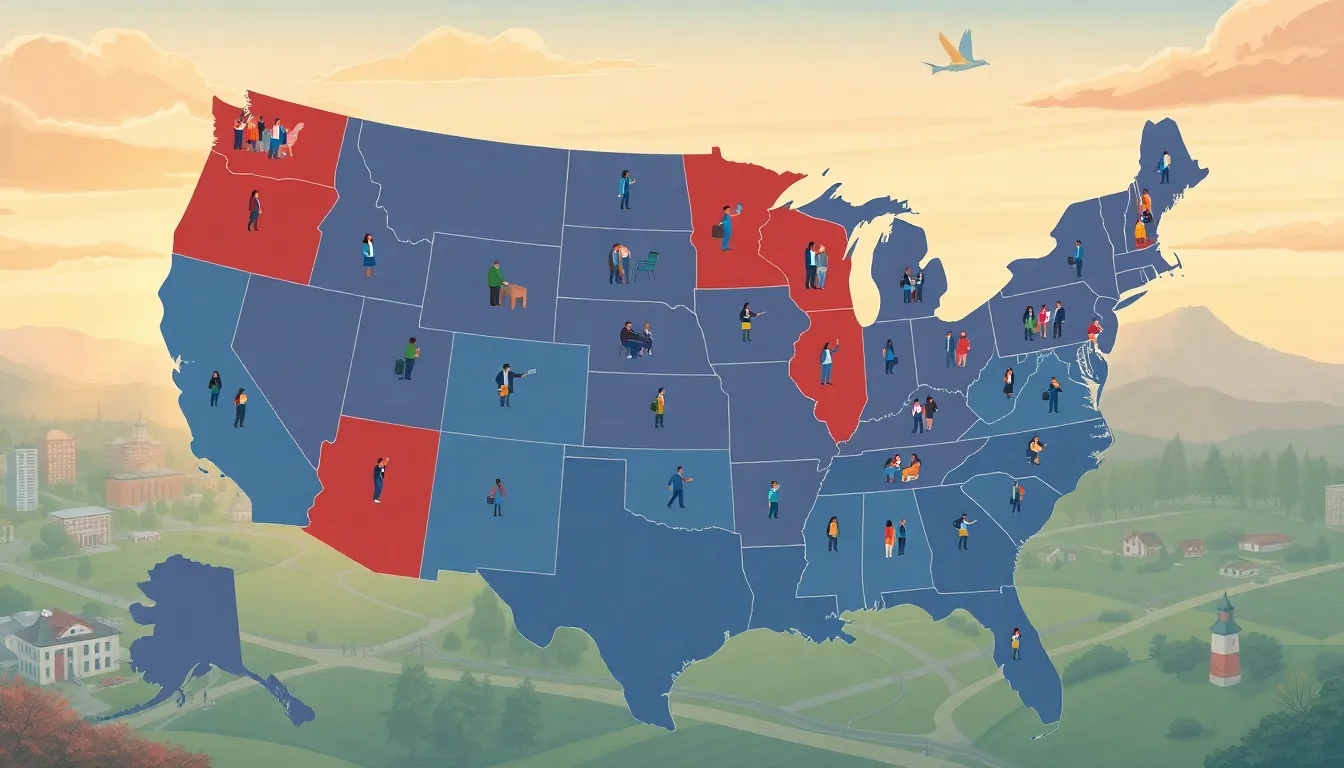As the 2024 United States election approaches, the stakes couldn’t be higher. Picture this: a colorful map that’s more dynamic than a toddler with a sugar rush. Every shade tells a story, and every line represents a fierce battle for power. The election map isn’t just a bunch of states; it’s a canvas of political drama, where candidates fight for their place in history while voters decide who gets to steer the ship.
Table of Contents
ToggleOverview of the 2024 United States Election Map
The 2024 United States election map reflects significant shifts in voter demographics, political affiliations, and regional priorities. Candidates focus on battleground states to secure crucial electoral votes. Recent trends indicate a growing divide in urban and rural voting patterns, highlighting the importance of localized campaigns.
Key states such as Pennsylvania, Wisconsin, and Michigan emerge as pivotal areas for both major parties. These states demonstrated thin margins in previous elections, making them highly sought after in 2024. Additionally, southern states like Georgia and Arizona now attract attention due to their changing voter bases and emerging competitiveness.
Voter turnout will play a critical role in determining the election’s outcome. In 2020, turnout reached remarkable levels, and projections for 2024 suggest similar engagement. Polling data reveals that issues like inflation, healthcare, and climate change resonate with voters, influencing their decisions at the ballot box.
The electoral landscape also features a possible third-party impact. Candidates from independent and smaller parties could siphon votes from the major parties, altering traditional dynamics. An analysis of party registration trends indicates an increasing number of voters identifying as independents, which may prove decisive in close races.
As the campaign progresses, the election map will evolve based on new information and voter sentiment. Each candidate’s strategy will adapt to reflect shifting priorities and the nuanced political climate across states. Understanding these dynamics offers crucial insight into the potential outcomes of the 2024 election.
Key Features of the 2024 United States Election Map

The 2024 United States election map presents a detailed view of changing political dynamics. Voter demographics are evolving, significantly influencing electoral outcomes.
Geographic Distribution of Voter Demographics
Geographic distribution plays a vital role in shaping the election landscape. Areas like urban centers typically lean Democratic while rural regions often support Republican candidates. New voting blocs, including younger voters and diverse communities, emerge across the map, particularly in states with high immigration rates. Suburban areas show notable shifts, with many voters aligning with issues such as healthcare and education. This evolving demographic landscape indicates that candidates must tailor their messages to resonate with various groups across states. Understanding these patterns offers insights into strategic campaign decisions leading up to the election.
Swing States and Their Importance
Swing states become critical battlegrounds in the 2024 election. States such as Pennsylvania, Wisconsin, and Michigan hold pivotal electoral votes, often deciding the outcome of the presidency. Each of these states exhibited narrow margins in previous elections, making them prime targets for candidates. Emerging competition in states like Georgia and Arizona introduces new dynamics, as changing voter bases impact traditional party strongholds. Voter turnout in these swing states is essential, especially amid pressing issues such as inflation and climate change. Candidates will prioritize their resources and campaigns in these areas to sway undecided voters.
Political Implications of the Election Map
The 2024 election map reveals critical political implications for the major parties. Significant shifts in voter demographics influence strategies as candidates prepare for intense competition.
Potential Outcomes for Major Parties
Democratic candidates may focus on urban centers where support remains strong. They aim to mobilize young voters and diverse communities. Republican candidates, however, concentrate on rural areas, leveraging traditional strongholds. Battleground states like Pennsylvania, Wisconsin, and Michigan hold paramount importance due to their thin margins in past elections. Each party’s ability to adapt messages and appeal to specific voter segments could shape electoral outcomes significantly. Predictions suggest that winning these states could lead one party to gain a substantial advantage in the Electoral College.
Impact on Local Races
Local races face considerable influence from the national election map. Candidates adapt platforms based on prevailing state issues, reflecting changing political sentiments. Data indicates that increased voter turnout in battleground states heightens competition for local positions. Suburban shifts create new dynamics, compelling local candidates to focus on key issues, such as education and healthcare. Dynamics in states like Georgia and Arizona exemplify how local elections mirror national trends. Overall, the ripple effect from national contests shapes candidates’ strategies across various local races.
Analysis of Historical Trends
The 2024 election map reveals significant historical trends that shape the political landscape. Analyzing previous elections provides insights into current dynamics.
Comparison with Previous Elections
Compared to the 2020 election, the 2024 election showcases evolving voter demographics. Pennsylvania, Wisconsin, and Michigan consistently highlight pivotal electoral votes. Shifts in voter turnout are evident, especially in suburban regions that previously leaned Republican. Candidates are responding to these changes by tailoring their messages to resonate with new audiences. Data from past elections indicates that these battleground states played vital roles in determining outcomes. Voter engagement strategies differ across the political spectrum, reflecting varying approaches among candidates.
Changes in Voter Behavior
Recent elections display marked shifts in voter behavior. Younger voters and diverse communities have emerged as critical groups influencing outcomes. Urban areas typically lean Democratic, with candidates focusing campaigns on healthcare and education issues. Furthermore, rural populations continue their support for Republican candidates, but trends show some suburban voters are changing affiliations. Increased emphasis on local issues highlights how candidates adapt strategies based on community needs. As the election approaches, understanding these behavior changes remains essential for both parties aiming for success.
The 2024 United States election map is shaping up to be a critical battleground reflecting the nation’s evolving political landscape. As candidates navigate shifting demographics and regional priorities their strategies will play a significant role in determining electoral outcomes. The focus on key swing states remains essential as they hold the power to sway the presidency.
With new voting blocs emerging and traditional strongholds being challenged understanding these dynamics will be crucial for both parties. Voter engagement in these pivotal areas could redefine the political narrative in the months leading up to the election. As the race intensifies the stakes couldn’t be higher for candidates aiming to resonate with an increasingly diverse electorate.



